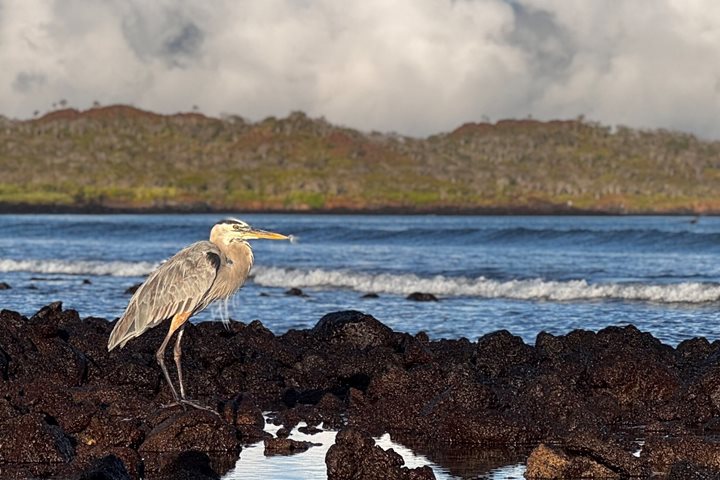Floreana, otherwise known as Santa Maria, is the island with the richest human history by far. For hundreds of years it was used as a hideout for pirates, allowing them to access fresh water and giant tortoises, which they hunted for meat. Later when Ecuador took possession of the archipelago, Floreana was designated as the first capital of Galapagos, and a few years later, it was visited by the famous naturalist, Charles Darwin.
Early in the morning, we started our day with a pre-breakfast hike at Punta Cormorant. The green landing beach looked spectacular, with the minerals shining with the first beams of sun, while on the branches of mangroves, curious pelicans observed us attentively. Farther into the trail, a natural symphony of songs was sung by the various land birds found in the area: small ground finches, yellow warblers, and flycatchers. But the greatest moment occurred when we reached the shore of the lagoon behind the beach, when we were captivated by more than thirty greater flamingos walking along the shallows, feeding on small crustaceans and leaving an unmistakable muddy track behind.
Once we reached the other side of the bay, the white sandy beach contrasted with the greenery of the first one. We observed fresh sea turtle’s tracks everywhere. Females obviously were here last night, laying their eggs, and early in the morning before dusk they returned to the ocean to start a long journey through the Pacific Ocean. As soon as returned to the National Geographic Endeavour, we started our navigation to our next destination: Champion Islet. Once we arrived, we started our adventure with a delightful Zodiac ride along the coastal zone of Champion Islet; along the shore, playful Galapagos sea lions wrestled with each other and nipped at the edges of our Zodiacs. We navigated to the cliff area, where we enjoyed the presence of lots of sea birds make their nests here. Just as we were getting ready to return to the ship, we finally had the opportunity of sighting one of the rarest birds of the Galapagos: the Floreana mocking bird. These birds are highly endangered, with less than 500 individuals, due to predation at the hands of introduced animals. After our Zodiac ride activity, we returned to Champion for deep water snorkeling. As soon as we entered the water, the marvels of the Galapagos Marine Reserve were revealed to us: colorful reef fishes of different species were swimming from rock to rock, but the most emblematic creature of all was definitely the Galapagos sea lions, that showed off their excellent swimming skills, darting all around and coming very close to us.
In the afternoon, we continued our exploration by visiting one of the most historical places of the Galapagos: Post Office Bay. After a wet landing, our youngest explorers had chance to swim from the marvelous white sandy beach. Afterwards we continued with one of the oldest Galapagos traditions, by going through the postcards that had been left in the post office barrel by previous visitors, looking for anything addressed to our hometown, so that we could hand deliver them when we return home. We also had the chance to leave a postcard of our own, for the next group of explorers who visit this place. Late the end of exploration, when everybody had returned aboard, we enjoyed a unique sunset, observing as little by little the sun disappeared in the horizon, telling us this day was over, but we are left with the best memories of this incredible day in paradise.







